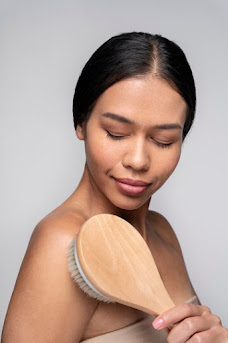Health Watch (Cupping Therapy)
Cupping Therapy Leaves a Mark With Effective Remedy
Cupping therapy, also known as horn
treatment or Hijama in Arabic, is a kind of suction or vacuum therapy
wherein specialised cups are placed on the skin surface of the patient to
inflate the underlying tissue. This, in turn, spurts the blood flow to the
affected areas, thus helping remove toxins or impurities from the body tissues
and organs to provide cure. Cupping therapist Hr. Imranali Sayed and physiotherapist
Dr. Chinmoy Medhi talk us through this ancient practice that is grabbing
attention of late.
By PRAMITA BOSE
Cups of substance:
- · Dry cupping is performed with several materials like animal horns, glass, bamboo, porcelain, silicone, neoprene or synthetic rubber, PVC plastic and disposable plastic cups.
- · Whereas wet cupping also requires a suction gun or machine, surgical blade, tissue paper, cotton, oil, etc.
Teeming benefits:
- · Merits of cupping therapy are countless. It is used for preventive measures as well as mental, physical and spiritual well-being.
- · Toxicity can be removed, while blood, veins and arteries are refreshed.
- · Cupping therapy balances the yin and the yang — the negative and positive energies within the body (according to Chinese philosophy). This method increases blood motion in the intended areas where cups are placed, thereby lowering muscle tightness, bettering overall circulation and facilitating the recovery process at cellular level.
- · Cupping regime can further trigger development and growth of fresh connective tissues and new blood vessels in which it is applied.
- · Cupping certainly helps reduce stress and brings about relaxation of the mind, primarily owing to the release of feel-good or happy hormones like dopamine and endorphin plus chemicals along with better lymphatic drainage systems and an improved blood circulation.
- · It also addresses infertility issues.
Curative properties:
- A slew of diseases can be cured through cupping and the list looks endless.
- · To name a few, any pain, headaches, back pain, arthritis, period pain, sciatica and emotional problems can be addressed by cupping therapy.
- · Cupping strengthens immune system, solves skin problems, digestive disorders, migraine, controls hypertension, manages stress and depression among others.
- · However, every therapy confronts limitations and cupping is no different. Genetic disorders, congenital cases, Down syndrome, cerebral palsy and accidental cases remain outside its purview.
- · To put it in perspective, cupping actually mitigates the symptoms of the disease. When combined with other treatments in a holistic manner, cupping can act as a key catalyst, contributing to the overall management and treatment of certain diseases. In other words, it results into a patient's well-being.
Disadvantages of cupping:
- · Side effects do not necessarily emanate with every cupping session. Some side effects from cupping may include burns or blisters from fire cupping.
- · A tingling effect or itchiness due to dryness of the skin
- · Slight discomfort
- · Light scratches from wet cupping or HIJAMA
- · Dark circular marks (which gradually disappear completely). The scars generally vanish in a week’s time. But in rare and exceptional cases, it may take up to 12 to 15 days.
- · Good news is that cupping does not induce any allergies even in sensitive skin-types. On the contrary, it helps get rid of allergies.
Health Caution
To be on the safe side, people who bleed easily and profusely, have injuries or bruises that heal slowly, have open or swollen wounds, suffer a disorder that involves involuntary movements, individuals with deep vein thrombosis, broken bones, very high blood pressure or sugar levels and ladies during their pregnancy should abstain from undergoing cupping therapy as that could be risky. Normally, there’s no defined standard duration of a cupping session. It depends on case-to-case basis and is investment-worthy.
 |
| Dr. Chinmoy Medhi |
Factoid
Hijama as an Arabic
term has multiple connotations. The term specifically means ‘sucking’ or ‘drawing out’ in the context of cupping therapy.
Cupping therapy has
evolved over time in various cultures. For instance, in African, the Middle
Eastern, Greek and Chinese cultures, cupping has been practiced for thousands
of years via the suction method.
Ebers Papyrus, one
of the time-honoured medical records written in 1500 BC, refers to the use of
cupping therapy by the Egyptians. The scenes of cupping sessions are engraved
on pyramids and archaeologists too found evidence of the therapy in China that
dates back to 1000 BC. Noted Greek physician, philosopher and the father of
medicine Hippocrates and the well-known fellow Greek historian, geographer and physician Herodotus wrote about the
powers of cupping regime way back in 413 BC.
Cupping therapy is also called Hijama and horn treatment. Each of these
long-established terms is chronicled in the annals of medical inventions.
Hijama denotes wet cupping wherein small skin cuts are made before
placing the cups to suck out a portion of the patient’s fresh blood. It carries
a lot of significance in Islamic culture and has been exercised in the Middle
East and North African regions as a cleansing process or detoxification and as
pain management as well.
Horn Treatment is as ancient as thousands of years and is partly
characterised by its technique of using an animal’s hollowed horns as the first
suction instruments. This was highly popular in China, Egypt and Greece. With the progression of time, horns were replaced with cups using glass, plastic as well
as silicone in conjunction with advanced medical technology and updated
knowledge.
***************************************************************************





Comments
Post a Comment